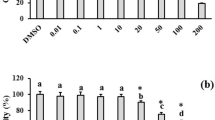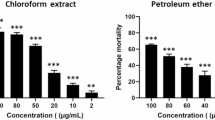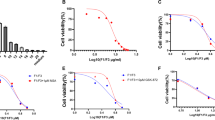Abstract
Aim:
Fluopsin C, an antibiotic isolated from Pseudomonas jinanesis, has shown antitumor effects on several cancer cell lines. In the current study, the oncotic cell death induced by fluopsin C was investigated in human breast adenocarcinoma cells in vitro.
Methods:
Human breast adenocarcinoma cell lines MCF-7 and MD-MBA-231 were used. The cytotoxicity was evaluated using MTT assay. Time-lapse microscopy and transmission electron microscopy were used to observe the morphological changes. Cell membrane integrity was assessed with propidium iodide (PI) uptake and lactate dehydrogenase (LDH) assay. Flow cytometry was used to measure reactive oxygen species (ROS) level and mitochondrial membrane potential (Δψm). A multimode microplate reader was used to analyze the intracellular ATP level. The changes in cytoskeletal system were investigated with Western blotting and immunostaining.
Results:
Fluopsin C (0.5-8 μmol/L) reduced the cell viability in dose- and time-dependent manners. Its IC50 values in MCF-7 and MD-MBA-231 cells at 24 h were 0.9 and 1.03 μmol/L, respectively. Fluopsin C (2 μmol/L) induced oncosis in both the breast adenocarcinoma cells characterized by membrane blebbing and swelling, which was blocked by pretreatment with the pan-caspase inhibitor Z-VAD-fmk. In MCF-7 cells, fluopsin C caused PI uptake into the cells, significantly increased LDH release, induced cytoskeletal system degradation and ROS accumulation, decreased the intracellular ATP level and Δψm. Noticeably, fluopsin C exerted comparable cytotoxicity against the normal human hepatocytes (HL7702) and human mammary epithelial cells with the IC50 values at 24 h of 2.7 and 2.4 μmol/L, respectively.
Conclusion:
Oncotic cell death was involved in the anticancer effects of fluopsin C on human breast adenocarcinoma cells in vitro. The hepatoxicity of fluopsin C should not be ignored.
Similar content being viewed by others
Log in or create a free account to read this content
Gain free access to this article, as well as selected content from this journal and more on nature.com
or
References
Majno G, Joris I . Apoptosis, oncosis, and necrosis. An overview of cell death. Am J Pathol 1995; 146: 3–15.
Van Cruchten S, Van Den Broeck W . Morphological and biochemical aspects of apoptosis, oncosis and necrosis. Anat Histol Embryol 2002; 31: 214–23.
Carson DA, Ribeiro JM . Apoptosis and disease. Lancet 1993; 341: 1251–4.
Fu D, Tian L, Peng Z, Deng W, Yuan J, Ma D, et al. Overexpression of CHMP6 induces cellular oncosis and apoptosis in HeLa cells. Biosci Biotechnol Biochem 2009; 73: 494–501.
Roque-Navarro L, Chakrabandhu K, de Leon J, Rodriguez S, Toledo C, Carr A, et al. Anti-ganglioside antibody-induced tumor cell death by loss of membrane integrity. Mol Cancer Ther 2008; 7: 2033–41.
Fadeel B, Orrenius S . Apoptosis: a basic biological phenomenon with wide-ranging implications in human disease. J Intern Med 2005; 258: 479–517.
Green DR, Reed JC . Mitochondria and apoptosis. Science 1998; 281: 1309–12.
Li X, Wu WK, Sun B, Cui M, Liu S, Gao J, et al. Dihydroptychantol A, a macrocyclic bisbibenzyl derivative, induces autophagy and following apoptosis associated with p53 pathway in human osteosarcoma U2OS cells. Toxicol Appl Pharmacol 2011; 251: 146–54.
Moriguchi A, Otani H, Yoshioka K, Shimazu T, Fujita M, Okazaki T, et al. Inhibition of contractile activity during postconditioning enhances cardioprotection by restoring sarcolemmal dystrophin through phosphatidylinositol 3-kinase. Circ J 2010; 74: 2393–402.
Buja LM . Myocardial ischemia and reperfusion injury. Cardiovasc Pathol 2005; 14: 170–5.
Espinosa E, Vara JA, Redondo A, Sanchez JJ, Hardisson D, Zamora P, et al. Breast cancer prognosis determined by gene expression profiling: a quantitative reverse transcriptase polymerase chain reaction study. J Clin Oncol 2005; 23: 7278–85.
Gast MC, Schellens JH, Beijnen JH . Clinical proteomics in breast cancer: a review. Breast Cancer Res Treat 2009; 116: 17–29.
Otsuka H, Niwayama S, Tanaka H, Take T, Uchiyama T . An antitumor antibiotic, No 4601 from Streptomyces, identical with YC 73 of Pseudomonas origin. J Antibiot 1972; 25: 369–70.
Ito S, Inuzuka K, Suzuki T . New antibiotics produced by bacteria grown on n–paraffin (mixture of C12, C13, and C14 fractions). J Antibiot 1970; 23: 542–5.
Shirahata K, Deguchi T, Hayashi T, Matsubara I, Suzuki T . The structures of fluopsins C and F. J Antibiot 1970; 23: 546.
Wang KR, Yan JX, Zhang BZ, Song JJ, Jia PF, Wang R . Novel mode of action of polybia-MPI, a novel antimicrobial peptide, in multi-drug resistant leukemic cells. Cancer Lett 2009; 278: 65–72
Li X, Zhao Y, Wu WK, Liu S, Cui M, Lou H . Solamargine induces apoptosis associated with p53 transcription-dependent and transcription-independent pathways in human osteosarcoma U2OS cells. Life Sci 2011; 88: 314–21.
Kroemer G, Galluzzi L, Brenner C . Mitochondrial membrane permeabilization in cell death. Physiol Rev 2007; 87: 99–163.
Kroemer G, Galluzzi L, Vandenabeele P, Abrams J, Alnemri ES, Baehrecke EH, et al. Classification of cell death: recommendations of the nomenclature committee on cell death 2009. Cell Death Differ 2009; 16: 3–11.
Sun L, Zhao Y, Yuan H, Li X, Cheng A, Lou H . Solamargine, a steroidal alkaloid glycoside, induces oncosis in human K562 leukemia and squamous cell carcinoma KB cells. Cancer Chemother Pharmacol 2011; 67: 813–21.
Malorni W, Iosi F, Mirabelli F, Bellomo G . Cytoskeleton as a target in menadione-induced oxidative stress in cultured mammalian cells: alterations underlying surface bleb formation. Chem Biol Interact 1991; 80: 217–36.
Neisch AL, Speck O, Stronach B, Fehon RG . Rho1 regulates apoptosis via activation of the JNK signaling pathway at the plasma membrane. J Cell Biol 2010; 189: 311–23.
Goldmann O, Sastalla I, Wos–Oxley M, Rohde M, Medina E . Streptococcus pyogenes induces oncosis in macrophages through the activation of an inflammatory programmed cell death pathway. Cell Microbiol 2009; 11: 138–55.
Cao X, Zhang Y, Zou L, Xiao H, Chu Y, Chu X . Persistent oxygen–glucose deprivation induces astrocytic death through two different pathways and calpain-mediated proteolysis of cytoskeletal proteins during astrocytic oncosis. Neurosci Lett 2010; 479: 118–22.
Jennings RB, Reimer KA . Lethal myocardial ischemic injury. Am J Pathol 1981; 102: 241–55.
Halestrap A . A pore way to die. Nature 2005; 434: 578–9.
Kalischuk LD, Inglis GD, Buret AG . Strain-dependent induction of epithelial cell oncosis by Campylobacter jejuni is correlated with invasion ability and is independent of cytolethal distending toxin. Microbiology 2007; 153: 2952–63.
Liu X, Schnellmann RG . Calpain mediates progressive plasma membrane permeability and proteolysis of cytoskeleton-associated paxillin, talin, and vinculin during renal cell death. J Pharmacol Exp Ther 2003; 304: 63–70.
Acknowledgements
This work was supported by grants from the National Natural Science Foundation of China (No 81273532) and the Shandong Provincial Natural Science Foundation (No ZR2011HQ028).
Author information
Authors and Affiliations
Corresponding author
Supplementary information
Rights and permissions
About this article
Cite this article
Ma, Ls., Jiang, Cy., Cui, M. et al. Fluopsin C induces oncosis of human breast adenocarcinoma cells. Acta Pharmacol Sin 34, 1093–1100 (2013). https://doi.org/10.1038/aps.2013.44
Received:
Accepted:
Published:
Issue date:
DOI: https://doi.org/10.1038/aps.2013.44
Keywords
This article is cited by
-
Potent anticancer activity of a novel iridium metallodrug via oncosis
Cellular and Molecular Life Sciences (2022)
-
Potent antitumor activity of a glutamyltransferase-derived peptide via an activation of oncosis pathway
Scientific Reports (2021)
-
Intervention timing and effect of PJ34 on astrocytes during oxygen-glucose deprivation/reperfusion and cell death pathways
Journal of Huazhong University of Science and Technology [Medical Sciences] (2015)



